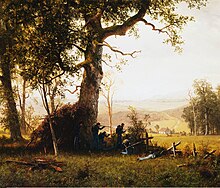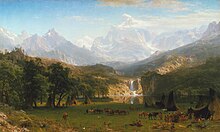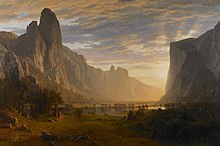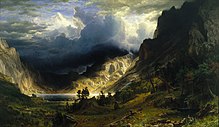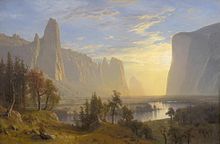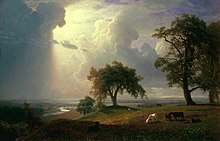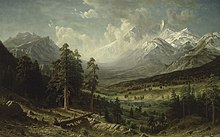Albert Bierstadt
Albert Bierstadt | |
|---|---|
 Portrait byNapoleon Sarony,c. 1870 | |
| Born | January 7, 1830 |
| Died | February 18, 1902(aged 72) New York City,U.S. |
| Nationality | American |
| Education | Düsseldorf School |
| Known for | Painting |
| Notable work | List of works |
| Movement | Hudson River School |
Albert Bierstadt(January 7, 1830 – February 18, 1902) was aGerman Americanpainter best known for his lavish, sweeping landscapes of theAmerican West.He joined several journeys of theWestward Expansionto paint the scenes. He was not the first artist to record the sites, but he was the foremost painter of them for the remainder of the 19th century.
Bierstadt was born inPrussia,but his family moved to the United States when he was one year old. He returned to study painting for several years inDüsseldorf.He became part of the second generation of theHudson River SchoolinNew York,an informal group of like-minded painters who started painting along theHudson River.Their style was based on carefully detailed paintings withromantic,almost glowing lighting, sometimes calledluminism.Bierstadt was an important interpreter of the western landscape, and he is also grouped with the Rocky Mountain School.[1]
Early life and education[edit]
Bierstadt was born inSolingen,Rhine Province,Prussia,on January 7, 1830. He was the son of Christina M. (Tillmans) and Henry Bierstadt, a cooper.[2]His older brothers were prominent stereo view photographersEdward BierstadtandCharles Bierstadt.Albert was just a year old when his family immigrated toNew Bedford, Massachusetts,in 1831. He made clevercrayonsketches in his youth and developed a taste for art.[3]
In 1851, Bierstadt began to paint in oils.[3]He returned toGermanyin 1853 and studied painting for several years in Düsseldorf with members of its informal school of painting. After returning to New Bedford in 1857, he taught drawing and painting briefly before devoting himself full-time to painting.[4]
Career[edit]
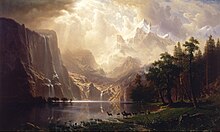

In 1858, Bierstadt exhibited a large painting of a Swiss landscape at theNational Academy of Design,which gained him positive critical reception and honorary membership in the Academy.[4]Bierstadt began painting scenes inNew Englandand upstateNew York,including in theHudson River Valley.He was part of a group of artists known as theHudson River School.
In 1859, Bierstadt traveled westward in the company ofFrederick W. Lander,aland surveyorfor the U.S. government, to see those western American landscapes for his work.[5]He returned to a studio he had taken at theTenth Street Studio Buildingin New York with sketches for numerous paintings he then finished. In 1860, he was elected a member of theNational Academy of Design;he received medals inAustria,Bavaria,Belgium,and Germany.[6][unreliable source?]
In 1863, Bierstadt traveled west again, this time in the company of the authorFitz Hugh Ludlow,whose wife he later married. The pair spent seven weeks in theYosemite Valley.Throughout the 1860s, Bierstadt used studies from this trip as the source for large-scale paintings for exhibition and he continued to visit the American West throughout his career.[7]The immense canvases he produced after his trips with Lander and Ludlow established him as the preeminent painter of the western American landscape.[8]Bierstadt's technical proficiency, earned through his study of European landscape, was crucial to his success as a painter of the American West and accounted for his popularity in disseminating views of theRocky Mountainsto those who had not seen them.[8]
During theAmerican Civil War(1861 to 1865), Bierstadt was drafted in 1863 and paid for a substitute to serve in his place. By 1862, he had completed one Civil War paintingGuerrilla Warfare, Civil Warbased on his brief experiences with soldiers stationed at Camp Cameron in 1861.[9]That painting was based on astereoscopicphotograph taken by his brother Edward Bierstadt, who operated a photography studio at Langley's Tavern in Virginia. The painting received a positive review when it was exhibited at the Brooklyn Art Association at theBrooklyn Academy of Musicin December 1861. CuratorEleanor Jones Harveyobserved that the painting, created from photographs, "is quintessentially that of a voyeur, privy to the stories and unblemished by the violence and brutality of first-hand combat experience."[9]
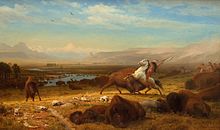
Financial recognition confirmed his status:The Rocky Mountains, Lander's Peak,completed in 1863, was purchased for $25,000 in 1865,[10]the equivalent of almost $400,000 in 2020.
In 1867, Bierstadt returned to Europe, arriving inLondonwhere he exhibited two landscape paintings in a private reception withQueen Victoria.[8]He then travelled through Europe for the next two years, painting new works while also cultivating social and business contacts to sustain the market for his art on the continent.[8]For example, he paintedAmong the Sierra Nevada, Californiain his Rome studio, displaying it inBerlinand London before having it shipped to the U.S.[11]His exhibition pieces both impressed European audiences and furthered the idea of the American West as a land of promise during a period when European emigration to the U.S. was increasing. Bierstadt's choice of grandiose subjects was matched by his entrepreneurial flair. His exhibitions of individual works were accompanied by promotion, ticket sales, and, in the words of one critic, a "vast machinery of advertisement and puffery."[11]
Bierstadt's popularity in the U.S. remained strong during his European tour. The publicity generated by hisYosemite Valleypaintings in 1868 led a number of explorers to request his presence as part of their westward expeditions. TheAtchison, Topeka, and Santa Fe Railroadalso commissioned him to visit and paint theGrand Canyonand surrounding region.[12]
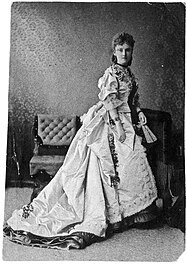
Despite his popular success, Bierstadt was criticized by some contemporaries for theromanticismevident in his choice of subjects and for his use of light, which they found excessive. Some critics objected to Bierstadt's paintings ofNative Americansbased on their belief that including Indigenous Americans "marred" the "impression of solitary grandeur."[7]
His wife, Rosalie, was diagnosed withtuberculosisin 1876, and Bierstadt spent increasing amounts of time with her in the warmer climate ofNassauin theBahamasuntil her death in 1893. He also maintained travel between the western United States,Canada,and his studio in New York.[8]
Though his painting career continued later into his life, Bierstadt's work fell increasingly out of critical favor and was increasingly attacked for its theatrical tone.[8]In 1882, a fire destroyed Bierstadt's studio atIrvington, New York,and, with it, many of his paintings.[3]

Bierstadt was a prolific artist, having completed over 500 paintings during his lifetime.[13]Yet by the time of his death on February 18, 1902,[14]the taste for epic landscape painting had long since subsided. Bierstadt was buried at theRural CemeteryinNew Bedford, Massachusetts,[2]and remained largely forgotten for nearly 60 years.[8]
Posthumous reception[edit]
Interest in Bierstadt's work was renewed in the 1960s with the exhibition of his small oil studies.[8]Modern opinions of Bierstadt have been divided. Some critics have regarded his work as gaudy, oversized, extravagant champions ofManifest Destiny.Others have noted that his landscapes helped create support for theconservation movementand the establishment ofYellowstone National Park.[7]His work has been placed in a favorable context, as stated in 1987:
The temptation (to criticize him) should be steadfastly resisted. Bierstadt's theatrical art, fervent sociability, international outlook, and unquenchable personal energy reflected the epic expansion in every facet of western civilization during the second half of the nineteenth century.[15]
On the other hand, his work has also been criticized as largely an imaginary depiction of nature, and even "soulless" in its execution.[16]
Existing work[edit]
- 1853 –Majesty of the Mountains
- 1855 –The Old Mill
- 1855 –The Portico of Octavia
- 1855 –Westphalia
- 1858 –Lake Lucerne,c. 1853, oil on canvas,National Gallery of Art,Washington, D.C.
- 1859 –The Wolf River, Kansas,[17]c. 1859, oil on canvas,Detroit Institute of Arts,Detroit,Michigan
- 1861 –Echo Lake, Franconia Mountains, NH,[18]Smith College Museum of Art,[19]Smith College,Northampton, Massachusetts
- 1863 –The Rocky Mountains, Lander's Peak,oil on canvas,Metropolitan Museum of Art,New York City,New York
- 1864 –Cho-looke, the Yosemite Fall,oil on canvas,Timken Museum of Art,San Diego,California[20]
- 1864 –Valley of the Yosemite,[21]oil on paper,Museum of Fine Arts,Boston,Massachusetts
- 1865 –Looking Down Yosemite Valley,Birmingham Museum of Art,Alabama[22]
- 1866 –Yosemite Valley,[23]Oil on canvas on panel-back stretcher,Cleveland Museum of Art,Cleveland, Ohio
- 1866 –On the Hudson River Near Irvington,1866–70, oil on paper,Berkshire Museum,Pittsfield, Massachusetts
- 1866 –A Storm in the Rocky Mountains, Mt. Rosalie,oil on canvas,Brooklyn Museum,New York City, New York
- 1868 –Connecticut River Valley, Claremont, New Hampshire,1868, oil on canvas,Berkshire Museum,Pittsfield, Massachusetts
- 1868 –In the Sierras,[24]Fogg Museum,Harvard University,Cambridge, Massachusetts
- 1868 –Among the Sierra Nevada, California,[25]Smithsonian American Art Museum,Washington, D.C.
- 1869 –Glen Ellis Falls,oil on canvas,Zimmerli Art Museum,New Brunswick, New Jersey
- 1870 –Sierra Nevada Morning,oil on canvas,Gilcrease Museum,Tulsa, Oklahoma
- 1870 –Puget Sound on the Pacific Coast,[26]oil on canvas,Seattle Art Museum,Seattle, Washington
- 1870 –Laramie Peak,oil on canvas, Buffalo AKG Art Museum, Buffalo, New York
- 1871 –Domes of Yosemite,[27]c. 1871,St. Johnsbury Athenaeum,St. Johnsbury, Vermont
- 1874 –Giant Redwood Trees of California,c. 1874, oil on canvas,Berkshire Museum,Pittsfield, Massachusetts
- 1875 –Mount Adams, Washington,1875, oil on canvas,Princeton University Art Museum,Princeton, New Jersey
- 1876 –Mount Corcoran,[28]c. 1876–77, oil on canvas,Corcoran Gallery of Art,Washington, D.C.
- 1888 –The Last of the Buffalo,[29]oil on canvas,Corcoran Gallery of Art,Washington, D.C.
- 1889 –Alaskan Coast Range,[30]c. 1889,Smithsonian American Art Museum,Washington, D.C.
- 1891 –The Last of the Buffalo,[31]c. 1891, vintage photogravure, Valley Fine Art Gallery,Aspen, Colorado
- 1895 –The Morteratsch Glacier Upper Engadine Valley – Pontresina
Selected paintings[edit]
-
Roman Fish Market, Arch of Octavius, 1858,De Young Museum,San Francisco, California
-
Gosnold at Cuttyhunk,c. 1858,New Bedford Whaling Museum,New Bedford,Massachusetts
-
The Marina Piccola, Capri,1859,Albright-Knox Art Gallery,Buffalo,New York
-
Indians Spear Fishing,1862,Museum of Fine Arts, Houston,Texas
-
Guerilla Warfare, Civil War,1862,Century Association,New York City
-
Oregon Trail (Campfire),1863
-
The Rocky Mountains, Lander's Peak,1863,Metropolitan Museum of Art,New York City
-
Valley of the Yosemite,1864,Museum of Fine Arts,Boston, Massachusetts
-
Staubbach Falls, Near Lauterbrunnen, Switzerland,1865
-
A Storm in the Rocky Mountains, Mt. Rosalie,1866,Brooklyn Museum,New York City
-
Yosemite Valley, Yosemite Park,c. 1868,Oakland Museum,California
-
Lake Tahoe,1868,Fogg Art Museum,Cambridge,Massachusetts
-
Storm in the Mountains,c. 1870,Museum of Fine Art,Boston,Massachusetts
-
Giant Redwood Trees of California,1874,Berkshire Museum,Massachusetts
-
California Spring,1875,De Young Museum,San Francisco, California
-
Sunrise on the Matterhorn,after 1875,Metropolitan Museum of Art,New York City
-
Estes Park, Long's Peak,c 1876-1877,Denver Art Museum,Colorado(on loan from the Denver Public Library)
-
Mount Corcoran,c. 1876–1877,Corcoran Gallery of Art,Washington, D.C.
-
Light in the Forest,unknown date
Legacy and honors[edit]

- Because of Bierstadt's interest in mountain landscapes,Mount BierstadtandBierstadt LakeinColoradoare named in his honor. Bierstadt was probably the first European to visit the summit ofMount Blue Skyin 1863, 1.5 miles from Mount Bierstadt.[32]Bierstadt named it Mount Rosa, a reference to bothMonte RosaaboveZermattand, Rosalie Ludlow, his future wife, but the name was changed from Rosalie to Evans in 1895 in honor of Colorado governorJohn Evans,and again in 2023 to Blue Sky.
- In 1998, theUnited States Postal Serviceissued a set of 20 commemorative stamps entitled "Four Centuries of American Art", one of which featured Albert Bierstadt'sThe Last of the Buffalo.[33]In 2008, the USPS issued a commemorative stamp in its "American Treasures" series featuring Bierstadt's 1864 paintingValley of the Yosemite.[34]
- William Bliss Baker,another landscape artist, studied under Bierstadt.
References[edit]
- ^"Picturing America's Natural Cathedrals".Tfaoi.RetrievedMay 20,2012.
- ^abGarraty, John Arthur; Carnes, Mark Christopher; Societies, American Council of Learned (March 29, 1999).American National Biography: Baker-Blatch.Oxford University Press.ISBN9780195127812– via Google Books.
- ^abcWilson, J. G.;Fiske, J.,eds. (1900)..Appletons' Cyclopædia of American Biography.New York: D. Appleton.
- ^ab"Artist Info".nga.gov.
- ^Mount CorcoranNational Gallery of Art, retrieved September 14, 2018
- ^Reynolds, Francis J., ed. (1921)..Collier's New Encyclopedia.New York: P. F. Collier & Son Company.
- ^abcHassrick, Peter H. (Spring 2018)."Art, Agency, and Conservation: A Fresh Look at Albert Bierstadt's Vision of the West".Montana The Magazine of Western History.68(1).
- ^abcdefgh"Bierstadt, Albert",National Gallery of Art. Retrieved February 2, 2018.
- ^abHarvey, Eleanor Jones (2012).The Civil War and American Art.Smithsonian American Art Museum; Metropolitan Museum of Art. Yale University Press.ISBN978-0-300-18733-5.
- ^"Albert Bierstadt: The Rocky Mountains, Lander's Peak (07.123) – Heilbrunn Timeline of Art History – The Metropolitan Museum of Art".metmuseum.org.
- ^ab"Among the Sierra Nevada, California by Albert Bierstadt / Exhibition Label".Smithsonian American Art Museum.2006.
- ^Barringer and Wilton, 250
- ^Glenda Moore (September 9, 2004)."xmission".xmission.RetrievedDecember 19,2012.
- ^Chisholm, Hugh,ed. (1911)..Encyclopædia Britannica.Vol. 3 (11th ed.). Cambridge University Press.
- ^Howat, John K., editor.American Paradise: The World of the Hudson River School,284. Metropolitan Museum of Art, New York, 1987.ISBN9780870994975
- ^Brenson, Michael (February 8, 1991)."Reviews/Art; He Painted the West That America Wanted".The New York Times.ISSN0362-4331.RetrievedAugust 1,2022.
- ^"Albert Bierstadt: The Wolf River, Kansas (61.28) — The Detroit Institute of Arts".Dia.org. Archived fromthe originalon February 23, 2009.RetrievedJuly 5,2013.
- ^"Echo Lake, Franconia Mountains, New Hampshire / North American / Art of the Americas / Highlights By Category / Collection Highlights / Collections / Smith College Museum of Art – Smith College Museum of Art".Scma.smith.edu. Archived fromthe originalon March 22, 2012.RetrievedJuly 5,2013.
- ^"Home / Smith College Museum of Art – Smith College Museum of Art".Smith.edu.RetrievedJuly 5,2013.
- ^"Cho-looke, the Yosemite Fall, 1864".Timken Museum of Art. Archived fromthe originalon February 21, 2009.
- ^"Valley of the Yosemite".RetrievedMay 31,2014.
- ^"Looking Down Yosemite Valley, California | Birmingham Museum of Art".June 16, 2023.RetrievedJune 18,2023.
- ^"Yosemite Valley".October 31, 2018.
- ^"In the Sierras".Harvard Art Museums.RetrievedJuly 5,2013.
- ^"Among the Sierra Nevada, California".Smithsonian American Art Museum. Archived fromthe originalon June 1, 2014.RetrievedMay 31,2014.
- ^"Puget Sound on the Pacific Coast".Seattle Art Museum. Archived fromthe originalon August 1, 2017.RetrievedJuly 31,2017.
- ^"St. Johnsbury Athenaeum>>This Week from the Gallery Archives".Stjathenaeum.org. Archived fromthe originalon September 27, 2013.RetrievedJuly 5,2013.
- ^"Mount Corcoran | Corcoran".Collection.corcoran.org. Archived fromthe originalon May 18, 2013.RetrievedJuly 5,2013.
- ^"The Last of the Buffalo | Corcoran".Collection.corcoran.org. Archived fromthe originalon May 18, 2013.RetrievedJuly 5,2013.
- ^"Alaskan Coast Range".Smithsonian American Art Museum. Archived fromthe originalon May 2, 2014.RetrievedMay 31,2014.
- ^"Valley Fine Art".Valley Fine Art Gallery.RetrievedMarch 2,2015.
- ^William Newton Byers,Bierstadt's Visit to Colorado: Sketching for the famous painting, "Storm in the Rocky Mountains",Magazine of Western History,Vol. 11, No. 3, Jan. 1890; page 237-240.
- ^"ArtOnStamps.org".ArtOnStamps.org. July 9, 2010.RetrievedMay 20,2012.
- ^"The Postal Store @ USPS".Shop.usps. March 28, 2011.RetrievedMay 20,2012.
Further reading[edit]
- Anderson, Nancy K. et al.Albert Bierstadt, Art & Enterprise,New York: Hudson Hills Press, 1990.
- Barringer, Tim and Wilton, Andrew.American Sublime: Landscape Painting in the United States 1820–1880,Princeton University Press, 2002.ISBN0-691-09670-8.
- Hendricks, Gordon.Albert Bierstadt, Painter of the American West,New York: Harrison House/Harry N. Abrams, Inc.,1988.
- American Paradise: The World of the Hudson River School.New York: The Metropolitan Museum of Art. 1987.ISBN9780870994968.
- Miller, Angela. "Albert Bierstadt, Landscape Aesthetics, and the Meanings of the West in the Civil War Era".Art Institute of Chicago Museum Studies27, no. 1 (Terrain of Freedom: American Art and the Civil War) (2001): 40–59 and 101–102.doi:10.2307/4102838.JSTOR4102838.
External links[edit]
- Works by or about Albert BierstadtatInternet Archive
- Albert Bierstadt(albertbierstadt.org)
- Albert Bierstadt Paintingsat fineartamerica
- White Mountain paintings by Albert Bierstadt
- A finding aid to the Albert Bierstadt letter collection, 1880–1893 in the Archives of American Art, Smithsonian Institution
- "Against His Grain: Albert Bierstadt's 'Clouds Over the Prairie'"MONA Moment, Museum of Nebraska Art
- Gallery of Bierstadt's PaintingsArchivedJanuary 26, 2021, at theWayback Machine
- The Winterthur Library—Overview of an archival collection on Albert Bierstadt.
- Albert Bierstadt Paintings Gallery—345 images online
- Albert Bierstadt's Biographyat The R.W. Norton Art Gallery
- "'Giant Redwood Trees' will fall at Berkshire Museum despite interpretive value ",The Berkshire Eagle,June 30, 2018
- Albert Bierstadt,WikiArt
- Albert BierstadtatFind a Grave
- 1830 births
- 1902 deaths
- 19th-century American painters
- 19th-century American male artists
- American male painters
- American landscape painters
- Artists of the American West
- Prussian emigrants to the United States
- Hudson River School painters
- Luminism (American art style)
- American frontier painters
- People from Solingen
- Artists from the Rhine Province
- People from Irvington, New York
- Düsseldorf school of painting
- Members of the American Academy of Arts and Letters





